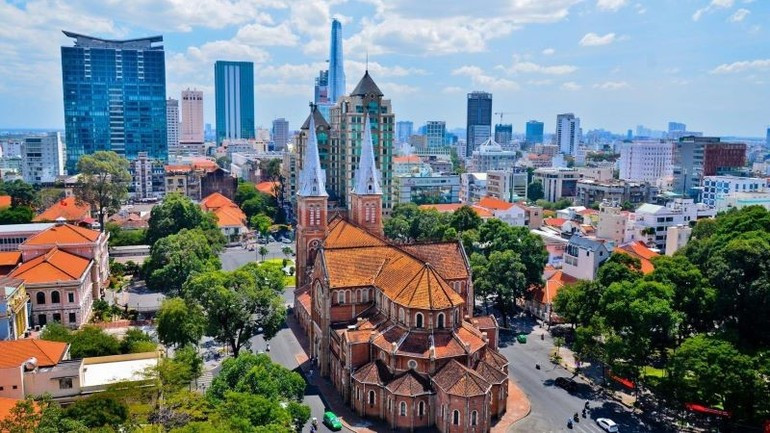Viet Nam emerges as a safe destination, attracting effective investment
In the context of strong fluctuations in the global economy and geopolitics, asset flows are shifting and tending to be selective about destinations, especially requiring the need to ensure living conditions and favourable conditions for long-term investment.

From traditional cities to emerging countries with friendly policies, the picture of asset allocation is changing rapidly. In that trend, Viet Nam is emerging as a potential destination if it seizes opportunities, improves policy conditions, infrastructure and quality of life.
Quality of life and investment conditions will create attraction
In the era of global economic fragmentation, the trend of “nearshoring” (transferring production or service activities to neighbouring countries or regions close to the main consumer market) and “onshoring” (producing on-site) has become strong, especially in high-tech, AI, chip manufacturing and data center industries that require quality human resources and stable energy.
For businesses, the problem of success still revolves around three main factors: people, energy and location. Advanced manufacturing industries now need quick access to suitable human resources and stable energy, factors that are increasingly scarce in the era of AI and data centre explosion. They also prioritise local ecosystems, where supply chains, strategic partners and supporting resources are present and interact effectively.
The “innovation cluster” model – where government, academia and businesses are closely connected – is seen as the key to future capital flows. Centres such as Silicon Valley (USA), Golden Triangle (UK) or Greater Bay Area (China) are not only headquarters but also ideal living destinations for the global elite. The intersection between quality of life and investment conditions here has created sustainable attraction.
Not only financial factors, they are also increasingly interested in “soft factors” such as culture, healthcare, education, international community and living experience. The Savills Dynamic Wealth Indices – published in the recent Savills Impacts report – has identified cities that are performing effectively in attracting and developing assets as well as investment capital from individuals and businesses.
Advantages and opportunities of Viet Nam
According to the Report from the Foreign Investment Agency under the Ministry of Finance, foreign investment flows into Viet Nam have continued to grow steadily despite the ongoing fluctuations in the global economy.
The latest report from the General Statistics Office under the Ministry of Finance shows that total foreign investment in Viet Nam in the first half of 2025 reached 21.52 billion USD, the highest in the past 5 years. The processing and manufacturing sector continues to play a leading role, 10.57 billion USD, accounting for 57.9% of the total newly registered and increased capital; real estate business activities reached 4.84 billion USD, accounting for 26.5%; the remaining sectors reached 2.84 billion USD, accounting for 30.6%.

Destinations such as Da Nang and Hoi An are emerging with high-end resort real estate, international standard golf courses and a temperate climate, with an increasingly improved quality of life. The emergence of branded real estate projects such as Nobu Residences or the Hoiana complex has contributed to reshaping the high-end segment of the market. Meanwhile, the two key economic centers of Ha Noi and Ho Chi Minh City are witnessing strong growth in luxury real estate, with international standard projects, upgraded transport infrastructure and convenient connectivity with other financial centers in the region.
In the wave of global asset reallocation, Viet Nam is facing a “window of opportunity” to attract the super-rich. Possessing many natural advantages and a strategic location, Viet Nam can completely become a center for investment, living and sustainable development.
New investment strategy in Viet Nam
After many global fluctuations and profound changes in the socio-economic context, the global real estate market is entering a new cycle, requiring investors to reposition their strategies. In Viet Nam, after a long period of purification, the market is also witnessing a series of positive recovery signals thanks to administrative reform and infrastructure investment.

In that context, the real estate investment strategy in Viet Nam needs to be clearly reoriented based on international lessons and practical conditions in the country.
The Impact 2025 report from Savills points out that the sustainable growth cycle that once made real estate a popular profit-making channel has now slowed down. The prolonged impact of the COVID-19 pandemic, changes in monetary policy and the global economy falling into a long-term stagnation have made the market fragmented, unpredictable and requiring a completely different investment mindset.
Interest rates remain high, making bond yields more competitive, while expectations for real estate capital appreciation have narrowed. The passive investment model - which depends on financial leverage and yield margins - no longer ensures the same efficiency as before. In that trend, investors need to shift to a proactive strategy, taking core cash flow, asset operation capability and long-term orientation as the foundation.
Specifically, from 2016 to 2024, the Vietnamese real estate market recorded strong growth in the residential, office and retail segments - especially in Ha Noi and Ho Chi Minh City - thanks to rapid urbanisation and increasing demand for modern living space. However, disruptions caused by the pandemic, tight credit policies and prolonged legal barriers have caused the market to enter a deep purification phase, with many projects stalled and investment sentiment gradually becoming cautious.
In response to this situation, structural reforms have been accelerated. The implementation of the revised Land Law, Housing Law and Real Estate Business Law from August 2024 has helped remove bottlenecks in approval procedures, enhancing transparency - a key factor in attracting long-term capital flows.
At the same time, public investment in infrastructure is accelerating nationwide, from Long Thanh airport, the North-South expressway to the beltways in Ha Noi and Ho Chi Minh City – facilitating regional connectivity, triggering a new wave of development in satellite cities.








